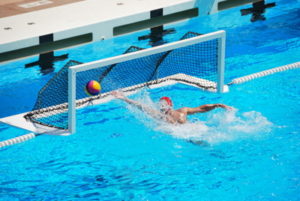 The cliché about swans is that they’re beautiful and elegant above the water whilst their legs are paddling like crazy underneath it. The comparison with water polo doesn’t quite work for the simple reason that things can look quite manic above the water, but there’s still something in it given the amount of gamesmanship that takes place underneath the waterline and out of the view of referees and the watching public.
The cliché about swans is that they’re beautiful and elegant above the water whilst their legs are paddling like crazy underneath it. The comparison with water polo doesn’t quite work for the simple reason that things can look quite manic above the water, but there’s still something in it given the amount of gamesmanship that takes place underneath the waterline and out of the view of referees and the watching public.
Little wonder, considering the immensely competitive nature of the sport, with two teams made up of a goalkeeper and six outfield players taking each on to outscore the opposition. The goalkeepers are only allowed to be defensive players, but the outfield players take on both defensive and offensive roles depending on the requirements of the match.
Professional water polo matches are played in pools that are deep enough to mean that players can’t touch the bottom, requiring them to tread water in order to stay afloat. Given the requirement to keep their upper body above water and use their arms to pass and throw the ball, it’s fair to say that water polo players have to demonstrate extreme levels of fitness.
It is widely considered to be one of the toughest sports to play, marking the extreme difference between the professional level and the level that you might have enjoyed playing on holiday!
Best Water Polo Betting Site
Coral

Coral are the biggest fish in the pool when it comes to Water Polo, and pretty much all aquatic based sports, even fishing. They can be relied upon to provide solid outright markets before major matches and tournaments as well as in-play betting, cash out and live stats during games.
There are no offers specifically for Water Polo but Coral have a good range of general sports promotions that can be applied to add value.
For other alternatives consider their sister site Ladbrokes as well as other big reliable bookies.
What Water Polo Markets Can You Bet On?
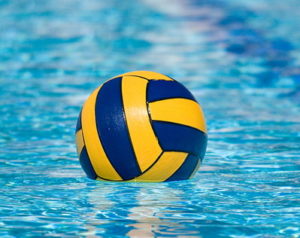 As with plenty of other obscure sports, betting on water polo is mostly limited to the key ante-post bets on the outright tournament winners with the majority of big bookmakers.
As with plenty of other obscure sports, betting on water polo is mostly limited to the key ante-post bets on the outright tournament winners with the majority of big bookmakers.
Some will allow you to bet on more specific things such as the winner of a given match, with specialist bookies also going so far as to allow you to bet on the likes of how many goals there’ll be in a match, handicap betting and so on.
The best thing to do is to either look for a bookmaker that specialises in water polo or else contact your bookie of choice and get them to quote you on certain markets.
The History Of Water Polo
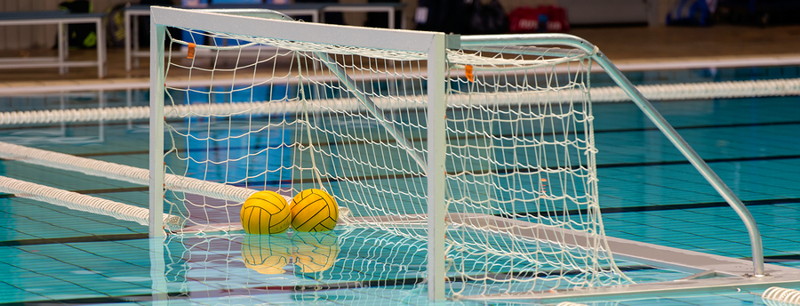
In order to know where water polo came from as a sport we have to travel back to the mid-19th century and to England and Scotland. Fairs and festivals were popular in Great Britain at the time, with water sports being one of the main events that would fill time with exhibition events.
You can see some of the more nefarious tactics of the modern game by looking at the sport’s origins, given that it was based on the notion of playing rugby in the lakes and rivers of the UK, with wrestling, holding players and the general demonstration of brute strength being high on the list of approved tactics.
The Sport’s Formative Years
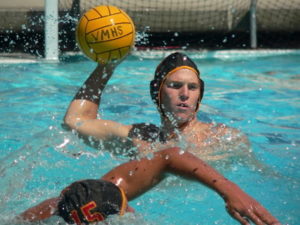 During the early years of water polo’s existence it was first known as water rugby, played with a ball made from Indian rubber. When Archibald Sinclair and William Henry published their book ‘Swimming’ they referred to a committee that the London Swimming Association had appointed in 1870 that was given the specific job of drawing up a code of rules for the burgeoning game of ‘football in the water’.
During the early years of water polo’s existence it was first known as water rugby, played with a ball made from Indian rubber. When Archibald Sinclair and William Henry published their book ‘Swimming’ they referred to a committee that the London Swimming Association had appointed in 1870 that was given the specific job of drawing up a code of rules for the burgeoning game of ‘football in the water’.
It had also been given other names like ‘aquatic-football’ and ‘water base-ball’, with the name of water polo not entering the records until September of 1873.
That was the year that the Morning Post and the Standard wrote of a match of ‘water polo’ being played at Crystal Palace in London. It’s believed that the name was a bastardisation of the Balti word ‘pulu’, which means ‘ball’.
Early rules included the idea that the goalkeeper actually stood out of the playing area and simply jumped on top of any player that was trying to score. The game was developing in Scotland at the same time, with Glasgow’s Arlington Baths Club seeing the sport played for the first time there.
The Game Becomes More Official
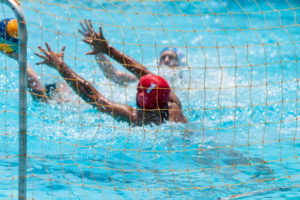 In 1884 the Midlands County Swimming and Aquatic Football Association set up what is almost certainly the world’s first water polo league. On the 13th of April 1885 the Swimming Association of Great Britain, which would later become the Amateur Swimming Association of England, officially recognised the sport for the first time.
In 1884 the Midlands County Swimming and Aquatic Football Association set up what is almost certainly the world’s first water polo league. On the 13th of April 1885 the Swimming Association of Great Britain, which would later become the Amateur Swimming Association of England, officially recognised the sport for the first time.
The following year the Scottish Amateur Swimming Association held the sport’s first championship, which saw West of Scotland achieve a 1-0 win over South Side. In 1888 England’s first national club championship was formed, fittingly being won by Burton Amateur Club, which had been formed ten years before.
The team that Burton beat in the final was Otter Swimming Club, which became one of the driving forces behind the formation of the London Water Polo League in 1889. The first international water polo match occurred in 1890 when a Scottish team defeated a team from England 4-0.
Two of the players that played in that match were the aforementioned Henry & Sinclair, who produced the book ‘Swimming’ in 1893. Soon leagues began springing up all around England, with the first match between Cambridge and Oxford occurring in 1891 and a club being formed in Manchester in 1892.
The Sport Moves Out Of The UK
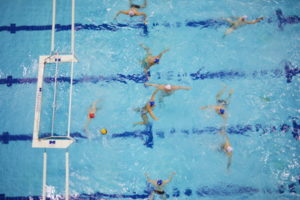 As the rules of the game developed to mean that it became slightly less violent, with players not allowed to be held under water any more and only the player with the ball being tackled, so too did its appeal to countries outside of England Scotland begin to grow.
As the rules of the game developed to mean that it became slightly less violent, with players not allowed to be held under water any more and only the player with the ball being tackled, so too did its appeal to countries outside of England Scotland begin to grow.
The Montreal Swimming Club had been formed in 1876 and by 1887 it had a water polo team, with matches played in the St. Lawrence River. The following year an English swimming instructor named John Robinson took the game to the United States of America when he introduced it to the Boston Athletic Association.
Soon clubs began to spring up around America, with J. H. Smith and Arnold Heilban creating the Sydenham Swimmers Club’s water polo team in Rhode Island in 1890. The New York Athletic Club played the game for the first time that year and Sydenham Swimmers Club defeated them in the country’s first championships.
In the decade that followed, the sport saw its popularity spread around Europe into the likes of Belgium, Austria and Germany. In spite of the sport only really moving outside of the UK when the rules were changed to make the game less violent, there were different codes played in Europe and the US with the latter’s code for the sport notably for the manner in which it allowed rough play.
The Game Becomes Formalised
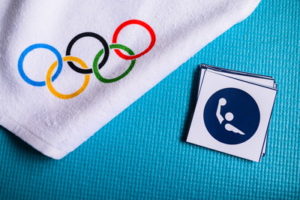 In 1900 the Summer Olympics added water polo to its roster, which was the first time that a team sport had been played in the modern Games. European teams refused to play on account of the different code played in the United States, leading to years of uncertainty regarding the official rules of the game. By 1914 the Americans had agreed to conform to international rules, but there was still no overall set of rules that everyone could abide by.
In 1900 the Summer Olympics added water polo to its roster, which was the first time that a team sport had been played in the modern Games. European teams refused to play on account of the different code played in the United States, leading to years of uncertainty regarding the official rules of the game. By 1914 the Americans had agreed to conform to international rules, but there was still no overall set of rules that everyone could abide by.
In 1929 an international water polo committee was formed with the hope being that it would put an end to the confusion and disputes that had dominated the sport on the international stage for so long.
The committee consisted of representatives from the International Amateur Swimming Federation, Great Britain and America. They decided on a set of rules that would apply to international matches and would come into effect in 1930. It was also confirmed that FINA would be the governing body for the sport from that point on.
Each time a new twist was put on the rules, such as Hungarian coach Béla Komjádi’s decision to encourage his players to pass the ball from hand to hand without letting it hit the water, FINA would be asked to rule on the matter. This included the 1949 decision to allow play to continue uninterrupted if a referee was only blowing their whistle for an ‘ordinary’ foul.
How To Play Water Polo
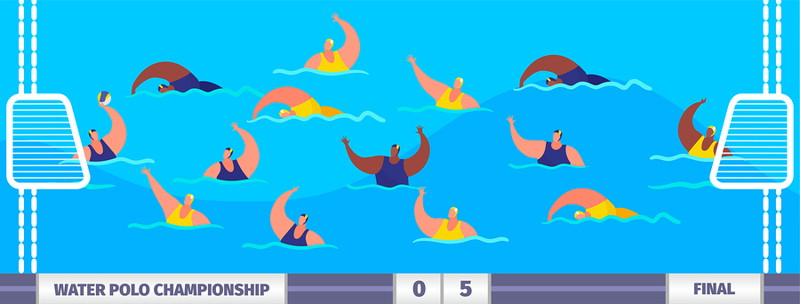
As you might well have gathered from reading other sections of this page, the rules of water polo haven’t always been straightforward when it comes to international variants. Indeed, even in the modern day there are slightly different versions of the game played depending on where in the world you are located.
There are many different governing bodies when it comes to water polo, with the following being the main ones:
- FINA: The International Swimming Federation is the international governing body
- NCAA: The National Collegiate Athletic Association defines the rules for US collegiate matches
- NFHS: The National Federation of State High School Associations is responsible for the rules played in high schools in the United States
- IOC: The International Olympic Committee is the governing body for Olympic sports
The Core Rules According To FINA
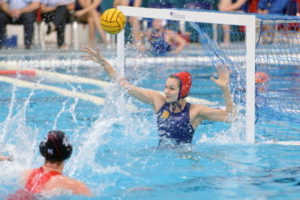 According to FINA, senior games are for teams of seven, which are made up of one goalkeeper and six outfield payers. There are also six substitutes that can come into and out of the game throughout; though it’s important to note that the goalkeeper can only be replaced by the substitute goalkeeper and outfield players can only be replaced by outfield substitutes.
According to FINA, senior games are for teams of seven, which are made up of one goalkeeper and six outfield payers. There are also six substitutes that can come into and out of the game throughout; though it’s important to note that the goalkeeper can only be replaced by the substitute goalkeeper and outfield players can only be replaced by outfield substitutes.
Players can only be substituted during the intervals between play, during a timeout and after a goal has been scored.
Matches are split up into four quarters of 8 minutes each quarter, with the clock being stopped every time the ball goes out of play. That means that quarters generally tend to last more like 12 minutes rather than the allotted 8.
The overall objective of water polo is to score more times than the opposition, which is achieved by throwing the water polo ball into the goal that the opposite team is trying to defend.
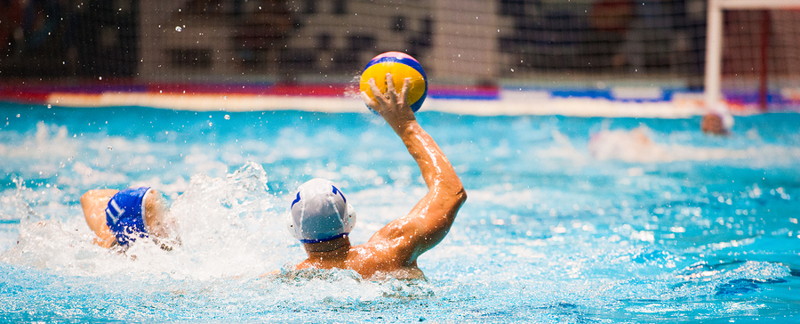
Each team is only allowed possession of the ball for 30 seconds, in which time they need to try to have a shot at goal. If they fail to do so then possession passes to the opposition.
In order to get the ball around the playing area, players can either push the ball in front of them or else throw it to teammates. Only the goalkeeper is allowed to use both hands, with everyone else restricted to one.
When quarters are first started, all players line up on their goal line and the ball is released into the middle of the pitch. The players then have to swim into the middle of the pitch to collect the ball before a player for the opposition. When a goal is scored, the team that conceded re-starts the match.
Officiating Water Polo Matches
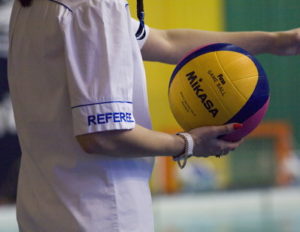 Matches are officiated by two match referees who each stand at one side of the pool. There are also table officials who are responsible for keeping time and keeping track of the correct information during matches.
Matches are officiated by two match referees who each stand at one side of the pool. There are also table officials who are responsible for keeping time and keeping track of the correct information during matches.
Yellow and red cards are issued during play for certain offences, with red cards requiring the player to leave the bench and often resulting in a one game suspension.
There are numerous different forms of foul in water polo, with the most common being the obstruction of an opposition player’s free movement. These sorts of things are known as ‘ordinary fouls’ or ‘minor fouls’, with the repeated commitment of such offences sometimes leading to players being excluded from play for 20 seconds.
The likes of dunking, splashing and pulling an opposition player is a major foul. The commitment of one of these types of fouls means a player is removed from play for 20 seconds. Other foul types include brutality fouls, where a player strikes or kicks an opponent, flagrant misconduct fouls, which results in a red card, and misconduct fouls for unsportsmanlike behaviour.
A major foul that is committed within the 5 metre area results in a penalty throw being awarded to the opposition. If the score is level at the end of normal time then a penalty shootout takes place, with each team alternating their shooter until one misses.
During play, teams can call a timeout.
Water Polo Equipment
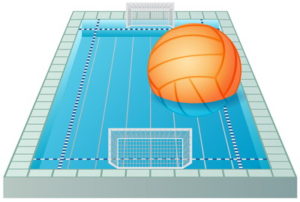 It goes without saying that the most crucial part of water polo is a swimming pool that is deep enough to require the players to tread water in order to stay afloat. The minimum water depth should be 1.8 metres, though in reality that isn’t always the case.
It goes without saying that the most crucial part of water polo is a swimming pool that is deep enough to require the players to tread water in order to stay afloat. The minimum water depth should be 1.8 metres, though in reality that isn’t always the case.
The actual dimensions of pools used for water polo aren’t fixed, meaning that they can be anywhere between 20 and 30 metres in length and 10 and 20 metres wide. Goals in water polo are 3 metres wide and 90 centimetres tall.
There is a white line to denote the middle of the pool, with a 5 metre line denoted by a yellow line 5 metres out from each goal. There is also a 2 metre line 2 metres from each goal, with no attacking player allowed to receive the ball within this segment.
Match officials can tell the teams apart because players must wear caps that differ from those warn by the opposite team and the goalkeepers as well as with the colour of the ball.
Obviously players have to wear suitable swimwear, but the other piece of crucial equipment is the ball. It is made of waterproof material and can float on the water, having a textured surface to allow players to grip it. There are different sized balls depending on whether it’s for the men’s or women’s game.
The Biggest Water Polo Tournaments
| Tournament | Details |
|---|---|
| Water Polo At The Summer Olympics | Men’s water polo has taken place at every Summer Olympics since 1900, with the women’s game only being added to the roster in 2000 |
| Water Polo At The World Aquatics Championships | Water polo has been part of the World Aquatics Championships since 1973, with the women’s game being added 13 years later. It takes place every 2 years |
| FINA Water Polo World Cup | Established in 1979, the Water Polo World Cup takes place every 4 years in the even years when there’s no Olympics. It is organised by FINA and is only for men’s teams |
| FINA Water Polo World League | This international league has only been taking place since 2000 and usually occurs annually between winter and June. It involves leagues being played for both men’s and women’s teams, with the top sides playing in the Super Final to discover the league champion |
Given the fact that water polo is popular around the world, it’s perhaps unsurprising that there are countless different tournaments in the sport that you can watch and bet on. The table above looks at the most high profile ones.
